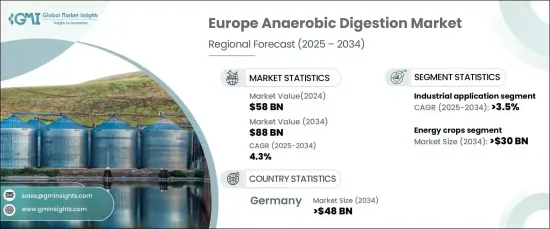PUBLISHER: Global Market Insights Inc. | PRODUCT CODE: 1666612

PUBLISHER: Global Market Insights Inc. | PRODUCT CODE: 1666612
Europe Anaerobic Digestion Market Opportunity, Growth Drivers, Industry Trend Analysis, and Forecast 2025 - 2034
Europe Anaerobic Digestion Market, valued at USD 58 billion in 2024, is projected to expand at a CAGR of 4.3% from 2025 to 2034. This growth is fueled by the increasing focus on renewable energy solutions, effective waste management strategies, and achieving sustainability targets. Businesses and policymakers are actively adopting anaerobic digestion technologies to transform organic waste into nutrient-rich digestate and biogas, aligning with the principles of a circular economy. Rising energy costs and a growing preference for biogas as a sustainable alternative to natural gas in power generation, heating, and transportation are driving this demand.

Continuous advancements in anaerobic digestion technologies, such as scalable and modular systems, have lowered operational costs, enabling widespread adoption in industrial, agricultural, and municipal applications. Investment in research and development has paved the way for innovation, particularly in enhancing efficiency through mixed feedstock co-digestion and optimizing methane production. Additionally, integrating anaerobic digestion with emerging technologies, including power-to-gas and carbon capture, is expanding its utility in achieving decarbonization objectives. These innovations are positioning anaerobic digestion as a critical solution for renewable energy generation while addressing environmental challenges.
| Market Scope | |
|---|---|
| Start Year | 2024 |
| Forecast Year | 2025-2034 |
| Start Value | $58 Billion |
| Forecast Value | $88 Billion |
| CAGR | 4.3% |
The energy crops market, an integral component of anaerobic digestion, is expected to surpass USD 30 billion by 2034. These crops, primarily cultivated for biofuel production, contribute to efficient energy conversion and maximize biomass yield per hectare. Energy crops are widely used in agricultural biogas plants due to their high energy density and rapid production capabilities, making them a cost-effective feedstock choice. This has significantly boosted their market penetration, driving growth in renewable energy adoption.
Industrial applications of anaerobic digestion are anticipated to grow at a CAGR exceeding 3.5% through 2034. The expansion of industrial sectors and the rising need for onsite power generation are key factors driving the adoption of anaerobic digestion systems. Biogas is increasingly used in internal combustion gas engines to generate heat and electricity simultaneously, supporting energy efficiency goals. The effective implementation of these systems relies on efficient logistics for feedstock collection and waste management. Furthermore, the push to reduce carbon footprints is encouraging industries to adopt anaerobic digestion systems as part of their sustainability initiatives.
In Germany, the anaerobic digestion market is forecast to exceed USD 48 billion by 2034, supported by robust renewable energy policies and strong decarbonization efforts. The country's commitment to biogas production, backed by substantial subsidies and advanced technologies, has solidified its position as a global leader in renewable energy. These developments underscore the growing importance of anaerobic digestion in meeting energy and environmental goals across Europe.
Table of Contents
Chapter 1 Methodology & Scope
- 1.1 Market scope & definitions
- 1.2 Market estimates & forecast parameters
- 1.3 Forecast calculation
- 1.4 Data sources
- 1.4.1 Primary
- 1.4.2 Secondary
- 1.4.2.1 Paid
- 1.4.2.2 Public
Chapter 2 Industry Insights
- 2.1 Industry ecosystem analysis
- 2.2 Regulatory landscape
- 2.3 Industry impact forces
- 2.3.1 Growth drivers
- 2.3.2 Industry pitfalls & challenges
- 2.4 Growth potential analysis
- 2.5 Porter's analysis
- 2.5.1 Bargaining power of suppliers
- 2.5.2 Bargaining power of buyers
- 2.5.3 Threat of new entrants
- 2.5.4 Threat of substitutes
- 2.6 PESTEL analysis
Chapter 3 Competitive Landscape, 2024
- 3.1 Introduction
- 3.2 Strategic outlook
- 3.3 Innovation & sustainability landscape
Chapter 4 Market Size and Forecast, By Feedstock, 2021 – 2034 (MW, USD Billion)
- 4.1 Key trends
- 4.2 Organic waste
- 4.3 Sewage sludge
- 4.4 Energy crops
- 4.5 Others
Chapter 5 Market Size and Forecast, By Process, 2021 – 2034 (MW, USD Billion)
- 5.1 Key trends
- 5.2 Wet AD
- 5.3 Dry AD
Chapter 6 Market Size and Forecast, By Application, 2021 – 2034 (MW, USD Billion)
- 6.1 Key trends
- 6.2 Residential
- 6.3 Commercial
- 6.4 Industrial
Chapter 7 Market Size and Forecast, By Country, 2021 – 2034 (MW, USD Billion)
- 7.1 Key trends
- 7.2 Austria
- 7.3 UK
- 7.4 Germany
- 7.5 France
- 7.6 Italy
- 7.7 Netherlands
Chapter 8 Company Profiles
- 8.1 Agrikomp
- 8.2 Bioconstruct
- 8.3 BTS Biogas
- 8.4 Envirochemie
- 8.5 Envitec Biogas
- 8.6 FWE
- 8.7 Host Bioenergy Systems
- 8.8 Larsen Biogas
- 8.9 Linde Engineering
- 8.10 Planet Biogas
- 8.11 Scandinavian Biogas Fuels
- 8.12 Sebigas
- 8.13 Thoni
- 8.14 Valmet
- 8.15 Weltec Biopower
- 8.16 Xergi




